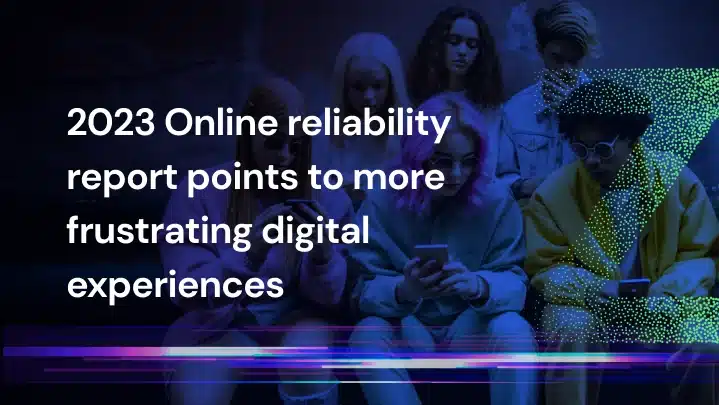From broadcast blackouts sending college football fans into a frenzy to pre-sale concert ticket site outages causing widespread hysteria, the inability to get things done in the event of an app or website glitch is taking an emotional toll on consumers in the United States.
Those are the findings of the 2023 Online Reliability Report, titled “Gone in a Glitch,” that we’re releasing today. Our survey points towards widespread dissatisfaction among American consumers, with 94% of respondents saying apps and websites are less reliable today than one year ago, leaving many feeling frustrated (71%), annoyed (65%) and even angry (26%). We also found that different groups of consumers react differently, with 1 in 4 members of Gen Z (25%) admitting to having cried at least once when an app or website went down. One-third of all respondents across all age groups said that online disruptions are more frustrating than being stuck in traffic or bad weather ruining their plans.
No longer just a cost of doing business
In today’s interconnected business environment, online platforms and businesses don’t only need to worry about their own downtime and outages, but also issues that affect their partners, collaborations, and service providers. Just like brick-and-mortar businesses need things like electricity or water to run their operations, there are a myriad of dependencies that could disrupt or degrade the experience for your customers.
Historically, many companies treated their digital presence as a kind of perpetual beta product. Many companies considered an occasional outage or buggy experience to be part of the normal cost of doing business, with occasional downtime being unavoidable. But today our daily lives are firmly enmeshed with always-on technologies. Consider this: 36% of Americans communicate more with other people through apps and websites than via traditional face-to-face communications or via text messaging.
However, this ubiquity comes at the cost of higher expectations. While customers might still tolerate the occasional disruption, consistent issues can jeopardize brand loyalty. As we’ll see, such lapses not only impact credibility but also risk significant customer attrition.
Of particular note is the Gen Z demographic. As they steadily amass purchasing power, their expectations from digital platforms are unequivocal. Research indicates that 25% of Gen Z consumers will transition to a competitor in response to slow or unreliable digital services. This “Gone in a Glitch” trend emphasizes the urgency for businesses to maintain seamless online operations.
While you may assume your brand’s glitches or outages are passing under your customer’s radar, our study indicates that almost all Americans (94%) have noticed apps and websites being less reliable than they were a year ago, with only 10% saying they rarely or never notice unreliability.
Additionally:
- 25% of customers (and 75% of Gen Z) report that they experience slow or glitchy apps and websites daily.
- 61% of consumers say they experience unreliable apps/websites at least once a week.
Real and reputational costs for glitchy experiences
Outages come in many flavors. From eager Taylor Swift fans looking for tickets to DDoS attacks leveraging new web vulnerabilities. But the truth is, whether it’s a bug, cyberattack, or infrastructure provider that causes an outage — consumers don’t care. All they understand is that they tried to do something with your business, and it didn’t work.
This attitude, coupled with the widespread opinion that online reliability is becoming worse over time, helps explain our findings as to why so many Americans have a backup plan. When encountering the first slowdown, glitch, or outage, 54% of consumers will first refresh or restart the app. If that doesn’t work, 36% (1 in 3) will then switch to a competitor or stop using the app altogether. On average, our survey shows that Americans will tolerate fewer than 4 instances of unreliability/outage on an app or website before switching to a competitor. Furthermore, 32% of Americans reported having multiple apps on their phone that do the same thing in case one isn’t working (for Gen Z this jumps to 43%), and 55% have pre-emptively saved details about their online accounts offline in case there is an outage.
They also don’t entirely differentiate between different kinds of outages. All told, 75% of Americans say they can forgive occasional outages, but that frequently experiencing slowdowns or glitches will cause them to stop using an app or website. Meanwhile, 55% of Americans say they are equally as likely to stop using an app or website that is slow to load and glitchy as they are one that is completely unavailable.
Brands on notice as consumer take unreliability personally
Ultimately, individuals are suffering increasingly higher personal costs when they experience glitches, and even in those instances where they are forced to use a buggy service, they don’t forget the experience. When having problems with an app or website, customers are quick to point fingers at the company behind the service they’re using. Over half (58%) blame the brand itself, more than other factors like the internet provider or hardware. In fact, many consumers (13%) feel they are outright owed something from an app or website during an outage. For Gen Z and Millennials, this climbs to 16% on consumers.
Understandably, customers’ emotional reactions to digital disruptions are strong indicators of their engagement with a brand — and turn negative when they experience an outage. Overall, 95% of consumers report adverse emotions when a digital platform doesn’t deliver as anticipated, underscoring the deep-seated need for reliability, with most consumers feeling frustrated (70%), annoyed (65%), and disappointed (37%).
These results have a clear conclusion: Reliability isn’t just a business metric — it’s the bedrock of lasting customer relationships and brand loyalty.
This survey, prepared by Method Research and distributed by Dynata, involved 2,000 American consumers ages 18+ that spend 3 or more hours a day online, and collected from May 25 to May 31, 2023.






